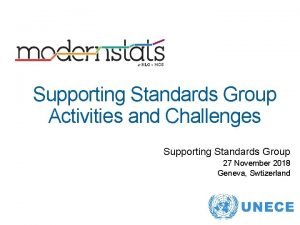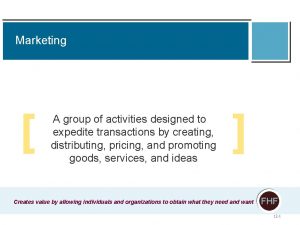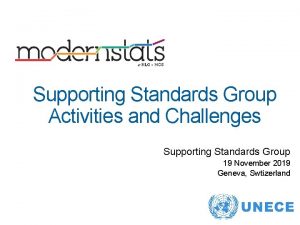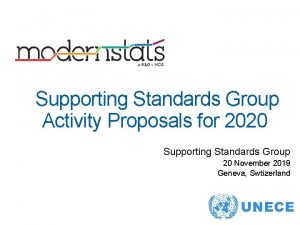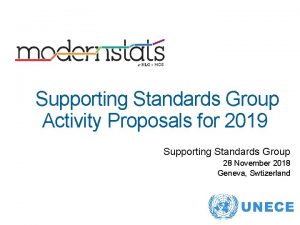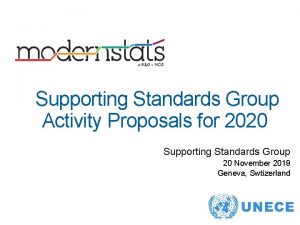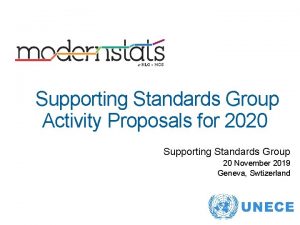Supporting Standards Group Activities and Challenges Marina Signore






















- Slides: 22

Supporting Standards Group Activities and Challenges Marina Signore and Eva Holm on behalf of the Supporting Standards Group

The Supporting Standards Group The goal of the group is to find ways how to develop, enhance, integrate, promote, support and facilitate implementation of the range of standards needed for statistical modernisation. Operational responsibility for the maintenance and development of: GAMSO - Generic Activity Model for Statistical Organizations GSBPM - Generic Statistical Business Process Model GSIM - Generic Statistical Information Model Documentation of CSPA - Common Statistical Production Architecture

The Members Member Country Organisation Marina Signore - Chair Italy ISTAT Al Hamilton Australian Bureau of Statistics Alice Born Canada Statistics Canada Guillaume Duffes France INSEE John Dunne Ireland CSO Mauro Scanu Italy ISTAT Francesco Bosio Italy ISTAT Juan Muñoz Mexico INEGI Manuel Cuellar Mexico INEGI Becky Collett New Zealand Statistics New Zealand Janusz Dygaszewicz Poland Statistics Poland Anna Dlugosz Poland Statistics Poland Klas Blomqvist Sweden Swedish Research Council Nilgün Dorsan Turkey Turkstat Dan Gillman United States Bureau of Labor Statistics Márta Nagy-Rothengass Eurostat Dana Müller German Federal Employment Agency (DDI) Joachim Wackerow GESIS (DDI) Edgardo Greising ILO David Barraclough OECD

Activities in 2017 GSIM Revision GSBPM Revision Metadata Glossary Workshop on Integrating Geospatial and Statistical Standards Quality Indicators 6 - 8 November 2017 Stockholm

The revision process for GSIM and GSBPM Why? – GSBPM v 5. 0 and GSIM v 1. 1 were released in 2013 – Need to take into account the changes in the statistical production environment – Take advantage from countries implementing the standards – Ensure greater alignment with new developments (e. g. GAMSO)

The revision process for GSIM and GSBPM How? – Two dedicated task teams (first joint meeting last April) – Discussion forum – Inputs from other Supporting Standards Task Teams – Take advantage from countries implementing the standards – Survey to collect users feedbacks (September 2017) – Ensure that there is a strong business case if major changes are made.

GSIM revision Specific features – The Review Team went over the list of compiled comments – The Team agreed that it is not possible to develop one GSIM that could address needs of every user with different backgrounds, hence the current cycle of revision should try to provide clearer definition and examples so that different users would know how to apply the model for different needs. – The Team acknowledged that GSIM is already being used in several organizations hence agreed that there should be a strong business case if major change is going to be made

GSIM revision Review input – Over 70 improvement proposals – The proposals • cover all GSIM Groups – Base, Business, Exchange, Structure and Concept • concerns all from small details to adding information objects

GSIM revision Specific features – Work done on Logical Information Model (LIM) to date should be included in the new GSIM release • LIM-variables will be included – LIM will remain as a development stream between GSIM revisions. – Recommendations to fix inconsistencies – Requests to add more detail based on implementation experience (e. g. in the Business part) – Improvements in how to explain GSIM – Making sure GSIM meets new ways of producing statistics – Better explanations on relationship to other models.

GSBPM revision Specific features – The Review Team identified general and specific issues and is analysing users feedback – General issues concern the alignment with GAMSO, particularly for the GSBPM overarching layers (Quality and Metadata management) – How to reflect processes related to non-survey data sources in GSBPM

GSBPM revision Specific features – Requests to share adaptations of GSBPM (e. g. national accounts) – Improvements in how to explain GSBPM – Better explanations on relationship to other models.

Metadata Glossary Purposes – Develop a general glossary of metadata covering the modernisation terminology and standards – Develop a glossary for those modernisation standards which did not have one yet – Combine existing glossaries (GSIM, CSPA. . . ) – Achieve synergies with existing glossaries (e. g. SDMX)

Metadata Glossary Main activities – A glossary for GAMSO terms was developed last year – A glossary for the GSBPM is to be completed by 2017 covering GSBPM phases and sub-processes – Definitions and explanatory text – Supporting the GSBPM revision by proposing improvements to text

Quality Indicators for the GSBPM Results – Quality Indicators for the Generic Statistical Business Process Model were developed for Statistics derived from Surveys (v 1. 0 released May 2016) – The work has been completed by adding quality indicators for administrative data sources Quality Indicators for the Generic Statistical Business Process Model (GSBPM) - For Statistics derived from Surveys and Administrative Data Sources (Version 2. 0, November 2017) – Support from the Communication Task Team in order to reach out relevant targets of potential users

Quality Indicators for the GSBPM Quality indicators were developed for each phase (1 to 8) and all sub-processes Quality and metadata management overarching process

Structure and characteristics of the QIs Quality Dimension ………. Indicator ……………. . Notes …………………. - Generic indicators to reflect the nature of GSBPM - Quantitative indicators whenever possible - Quality Indicators were harmonised with other international quality frameworks - The UN NQAF dimensions were taken as reference for relating QIs to the corresponding quality dimension but mapping to the ES Co. P was indicated only in case of discrepancies

Quality Indicators for the GSBPM Main uses – Complementing GSBPM with Quality Indicators supports a process-oriented approach in the organisations and in quality management – Can be tailored by Statistical Organisations according to their needs – Avoid duplication of work in different sectors within the organisation – Can be used to map/fill in gaps with QIs already in use in a Statistical Organisation

Future activities and challenges (1) GSBPM and GSIM revision – Business cases prepared by the Supporting Standards Group and submitted to the HLG-MOS for their approval – Proposed dates: • Start: November, 2017 • End: September, 2018

Future activities and challenges (2) Metadata Glossary – Business cases prepared by the Metadata Glossary Task Team and submitted to the HLG-MOS for their approval • GSBPM completed by December 2017 • GSIM by July, 2018 • CSPA by December, 2018 – Proposed dates: • Start: December, 2017 • End: December, 2018

Future activities and challenges (3) Integrated view of modernisation standards – Support to the implementation of the modernisation standards by taking advantage of their interrelationships – Provide answers to recurring questions (e. g. relationship between different standards, How to implement them together, which standard comes first) – Connect to the Maturity Model and the Roadmap so to enhance their usefulness – Proposal submitted for discussion tomorrow.

Future activities and challenges (4) Modern. Stats World Workshop 2018 – 11 -13 April 2018 – Purposes: facilitate the sharing of the ideas and plans for modernising statistical production by implementing the standards; increase the understanding of standards and their interrelations – Steering Committee of the Modern. Stats World Workshop • 15 people from Supporting Standards and the Sharing Tools Modernisation Groups • First meeting 10 November 2017

Future activities and challenges (5) Promoting standards – Encourage the greater visibility and use of standards within statistical organisations – Advertise the release of new products (e. g. Quality Indicators for the GSBPM) – Getting support from the Communication Task Team – Maintain cooperation with international organisations (Eurostat, OECD, ILO, …) to ensure the maximum of convergence
 Non chiunque dice signore signore
Non chiunque dice signore signore In these activities
In these activities Primary and support activities
Primary and support activities Examples of primary activities
Examples of primary activities Standards in group activity
Standards in group activity Factors determining service standards
Factors determining service standards Operating activities vs investing activities
Operating activities vs investing activities Existential group therapy activities
Existential group therapy activities A group of activities designed to expedite transactions
A group of activities designed to expedite transactions Lord of the flies pre reading activity
Lord of the flies pre reading activity Broken arrow lodge & marina
Broken arrow lodge & marina Ulay and marina abramovic
Ulay and marina abramovic Voglio ringraziarti
Voglio ringraziarti Pregate il padrone della messe
Pregate il padrone della messe Signore proteggici
Signore proteggici Signore donaci la pace
Signore donaci la pace Prendi e ricevi
Prendi e ricevi Philippe signore
Philippe signore Canto la pasqua del signore
Canto la pasqua del signore Mio dio mi pento e mi dolgo
Mio dio mi pento e mi dolgo Lettera di san paolo ai corinzi amore
Lettera di san paolo ai corinzi amore Signore proteggici
Signore proteggici Il signore della notte cipi
Il signore della notte cipi




